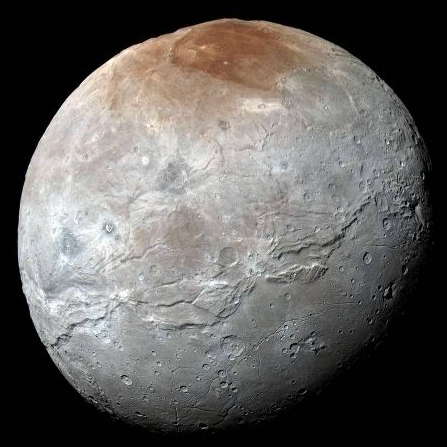Pluto's Moons
One thing that every planet needs is companionship. Pluto, a dwarf planet located far from the Sun, is far from lonely thanks to its five moons: Charon, Hydra, Nix, Kerberos, and Styx. Charon, the largest of these moons, has a diameter of 1,212 kilometres (753 miles) — about half that of Pluto's 2,376 km (1,476 miles). Charon is also situated close to Pluto at an average distance of just 19,596 km (12,176 miles). Compare this to Earth's moon which is 384,400 km (238850 miles) away from Earth. Pluto and Charon also orbit around a shared centre of gravity situated in between the two objects. This, combined with the fact that they are so close in size and in distance to each other, leads some astronomers to consider them to be a double dwarf planet system.

The other four moons - Hydra, Nix, Kerberos, and Styx - are significantly smaller. Hydra and Nix were the first to be found in 2005, while Kerberos was discovered in 2011 and Styx in 2012. The moons get their name from Greek mythology. Pluto is the Roman equivalent of the Greek god Hades, ruler of the Underworld. Its moon Hydra is named after a mythological serpent monster with many heads that guards the entrance to the Underworld. Nix (spelled Nyx in Greek mythology) is the goddess of the night, Kerberos (or Cerberus in mythology) is a three-headed dog that guards the gates to the Underworld. Styx is a river, or boundary between Earth and the Underworld. Seems like quite a pleasant family!
In 2015, the New Horizons space probe provided a closer look at Pluto and its moons, flying by them to obtain data and capture detailed new images of these fasincating little worlds in their quiet corner of the Solar System.
List of Pluto's Moons
| Name of Moon | Diameter | Orbital Distance | Length of Orbit | Discovered | Discoverer |
|---|---|---|---|---|---|
| Charon | 1,212 km
753 miles |
19,596 km 12,176 miles |
6 days and 4 hours | 1978 | James W. Christy |
| Styx | 16 km
(16 x 9 x 8 km) 10 miles |
42,650 km 26,501 miles |
20 days and 2 hours | 2012 | Mark Robert Showalter and team |
| Nix | 48 km
(48 x 33 x 30 km) 30 miles |
48,690 km 30,255 miles |
24 days and 21 hours | 2005 | Pluto Companion Search Team |
| Kerberos | 19 km
(19 x 10 x 9 km) 12 miles |
57,780 km 35,903 miles |
32 days and 4 hours | 2011 | Mark Robert Showalter and team |
| Hydra | 50 km
(50 x 36 x 32 km) 31 miles |
64,740 km 40,227 miles |
38 days and 5 hours | 2005 | Pluto Companion Search Team |





